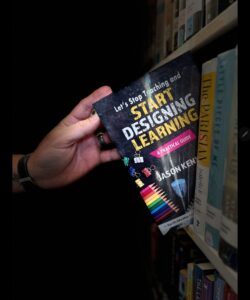For this week’s thoughts on quitting teaching to start designing learning, bear with the following metaphor with me. Right now, students line up outside of classroom doors in a vertical line, one behind the other. Those in the front are much closer to the classroom door, much closer to the learning about to take place inside. Now, while this random line up of students happens in the literal world, figuratively speaking the students in the “front of the line” come into learning with a lot more advantages than those behind them. These students in front come with parental support at home, extra money for supplies, benefits from an exceptional teacher previously, and a number of other factors. These students toward the front of the learning line will have less difficulty when engaging with instruction, communicating needs, and many other actions involving their learning.
Those students toward the “back of the line” are entering learning facing a great divide in front of them. They may not have parents who are able to assist them at home, additional supplies or resources, or been accelerated by a former teacher. These enter the room far behind their predecessors and may often face difficulty when learning.
Our job as educators is to transform this vertical line entering the classroom, where some students already have closer access to the learning while others have a longer distance to travel to get there, into a horizontal line where all students have equal access to the learning and mastery of the standards in our rooms. Teaching, in general, is often a “one-size-fits-all” delivery. This keeps that vertical line vertical. Those students with the preloaded advantages have much less farther to go to get to learning today. Those in the back of the line struggle to close the wide gap they walked into the classroom with.
Designing learning is the answer to making learning an equal reach for all students. Purposeful, instructional design will allow for the tools for misunderstanding to be in place, for tasks to be intentionally created with students at all places in the vertical line in mind, for acceleration pathways to be laid out for students wanting to go deeper in their learning. Designing learning takes the line they entered class in and rotates it, allowing all students to have the same access in reaching the learning goals of the lesson. The big surprise of it all is, designing learning really isn’t MORE work as many often assume or fear. Designing learning is just a little DIFFERENT work for the average teacher. It’s about shifting the focus of what we get paid to do, which is not teaching by the way. It is providing learning.
Our students line up in an order that is beyond their control outside of our classrooms. The second they enter, we must have learning designed and ready so that all can equally access it. This is the nature of education. It should be the great equalizer, and it is up to us as educators to do what it takes to provide this equity for our students. That means sometimes abandoning the “tried and true” because the way things have always been done is not working to level the playing field. Our students deserve no less from us. Design learning to give them the best and most equitable learning possible.


